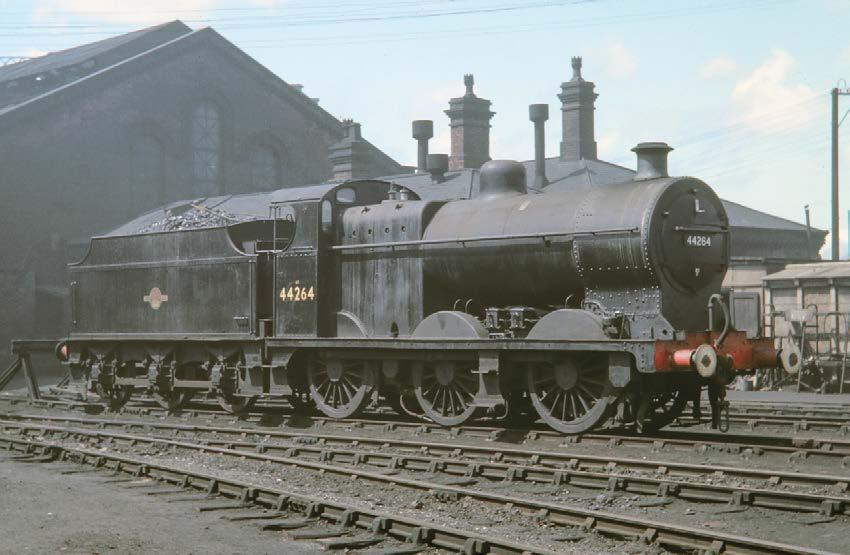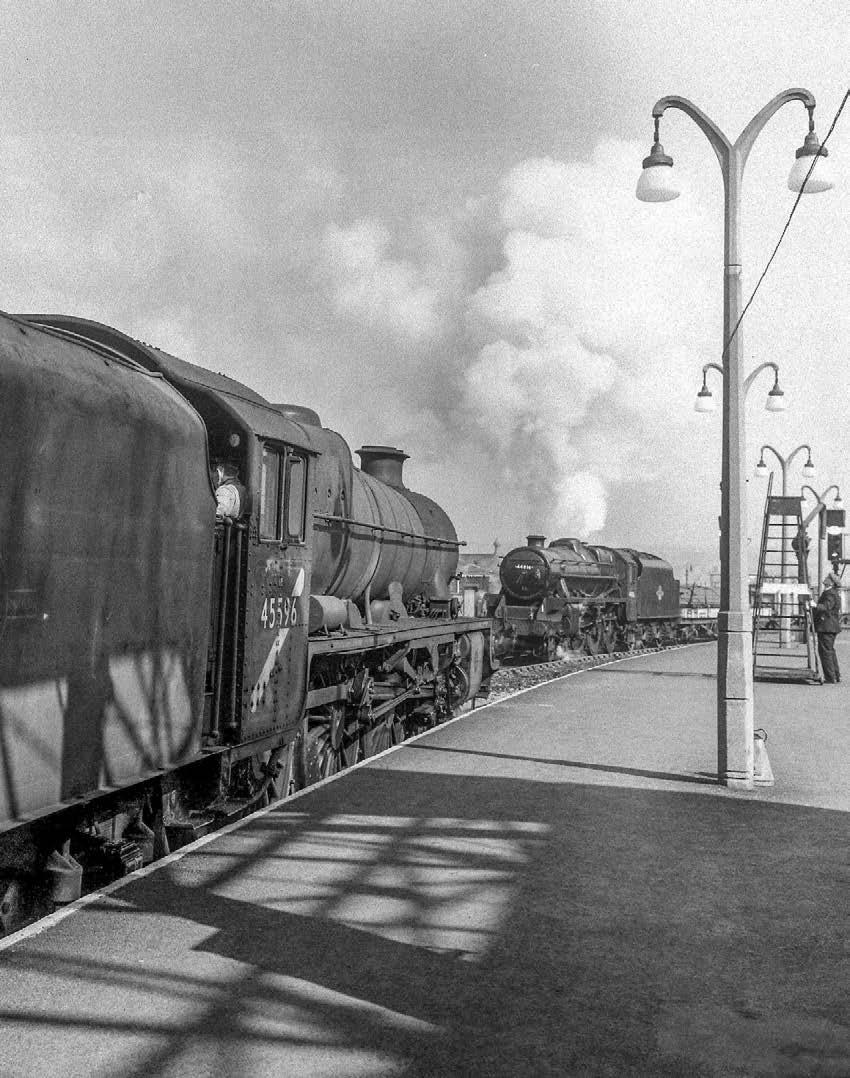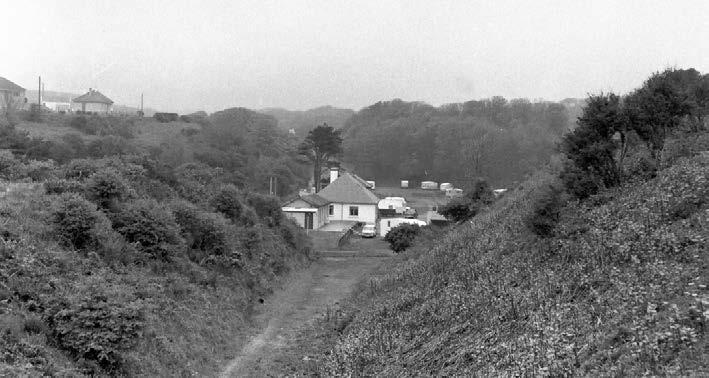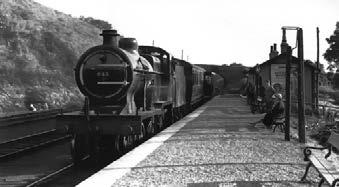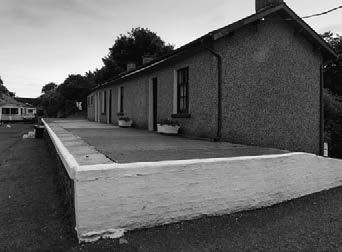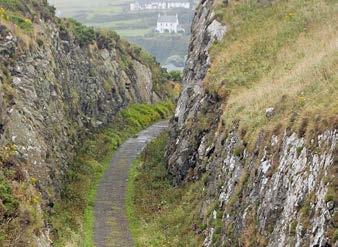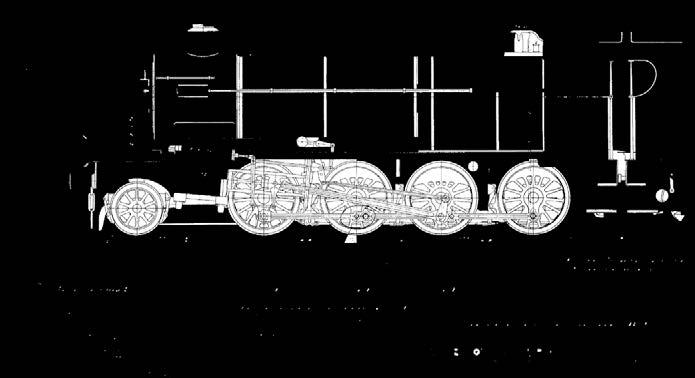The history periodical for students of the LMS, pre-grouping constituents and BR(M)
Issue no. 7 • March 2025
CONTENTS
27th October 1930 • Derby-built Fowler ‘Royal Scot’ Class 6P 4-6-0 No. 6169 The Boy Scout poses with members of the Scout movement for a publicity shot on its introduction into service.
Photo: © The Transport Treasury.
© Images and design: The Transport Treasury 2024. Design and Text: Peter Sikes ISBN: 978-1-913251-94-9
First published in 2025 by Transport Treasury Publishing Ltd., 16 Highworth Close, High Wycombe HP13 7PJ
The copyright holders hereby give notice that all rights to this work are reserved.
Aside from brief passages for the purpose of review, no part of this work may be reproduced, copied by electronic or other means, or otherwise stored in any information storage and retrieval system without written permission from the Publisher. This includes the illustrations herein which shall remain the copyright of the copyright holder.
Copies of many of the images in MIDLAND TIMES are available for purchase/download. In addition, the Transport Treasury Archive contains tens of thousands of other UK, Irish and some European railway photographs.
www.ttpublishing.co.uk or for editorial issues and contributions email MidlandTimes1884@gmail.com
Printed in England by Short Run Press Limited, Exeter.
LNW LINES THROUGH HUDDERSFIELD
by Philip Hellawell
30th March 1965 • Once a Huddersfield engine, but now of Stockport, Stanier ‘Jubilee’ Class 6P5F 4-6-0 No. 45596 Bahamas awaits departure eastwards at Huddersfield as ‘Black Five’ 4-6-0 No. 44816 is about to pass on a freight working.
Photo: Robert Anderson/The Transport Library.
The London and North Western Railway
In 1846, the London and North Western Railway Act authorised the amalgamation of the Grand Junction Railway, London and Birmingham Railway and the Manchester and Birmingham Railway into the London & North Western Railway (LNW). Headquartered at Euston, the LNW connected four of the largest cities in England; London, Birmingham, Manchester and Liverpool, and, through co-operation with the Caledonian Railway, also connected Scotland’s largest cities of Glasgow and Edinburgh. It is little wonder that the LNW’s main line (later dubbed the ‘Premier Line’) was later extensively used in the Grouping era, evolving into the West Coast main line we know today. By the late 19th century, the LNW had become the largest joint stock company in the world.
Whilst linking the major cities was the core of the LNW network, the company also acquired several other lines, principally in the Midlands and North Wales including, in 1858, the Chester & Holyhead Railway, which allowed it to run the lucrative Irish Mail trains to Holyhead. There were other innovations, such as the launch of the ‘Limited Mail’ service in 1859 and, in 1860, the pioneer use of water troughs, designed by John Ramsbottom. In 1873 the first sleeping carriage ran between Euston and Glasgow, attached to the ‘Limited Mail’, running three nights a week in each direction, extended to become nightly from February 1874 with a second carriage provided.
More amalgamations in the early 1900s added significantly to route mileage. By 1922, the LNW had completed the electrification of the whole of its London inner-suburban network, electricity being generated at its own power station in Stonebridge Park. As early as 1905 the LNW and the Lancashire & Yorkshire Railway (L&Y) had agreed to closer working where their interests overlapped and they finally merged in 1922, following which it became the biggest constituent of the London, Midland and Scottish (LMS) Railway at the grouping of 1923. Sir Josiah Stamp, President of the Executive at the outset, became Chairman of the LMS from 1927 to 1941. He believed that teamwork was the ultimate goal but in seeking to achieve fundamental unity he had to contend with converting staff from widely different regimes into LMS men. The company continued to struggle with the effect of the Midland’s outdated and inefficient small engine policy, so he manoeuvred Fowler out of office and headhunted William Stanier from Swindon as CME from 1st January 1932. Stanier then started the process of building a team of locomotive men at Crewe (rather than Derby) to develop his more powerful locomotive designs.
Original companies in the Huddersfield area
Frustration with the slow construction of the Leeds and Liverpool Canal led to the formation of the Huddersfield Canal Company (HCC) in 1794 to make a 20 mile narrow gauge connection between the Ashton Canal at Dukinfield through Stalybridge and Marsden to the Huddersfield Broad Canal at Aspley basin. Very slow progress was being made on this daring venture, the longest, deepest and highest canal in the country. The 3 mile 176 yards Standedge tunnel was particularly problematical. Work on both ends of the tunnel started at the same time but, in 1807, when Thomas Telford, the most renowned civil engineer of the time, was employed to sort things out, he discovered that the excavations were not only being dug at different depths, but also, they were not going to meet in the middle. However, by incorporating a number of bends, opening finally took place in April 1811, seventeen years after it started as opposed to the five years originally planned.
Financial restraints and cost cutting meant that there was only one single width tunnel and no tow path. Leggers propelled the boats by laying on top of boards at the side of the boat and walking it through. Unfortunately, boats from both ends would sometimes meet part way through, resulting in heated conversation and, sometimes, fighting in the near complete darkness. Eventually a timetable was devised, but this could cause congestion at the entrances.
The Manchester & Leeds Railway (M&L) had, in 1843, rejected proposals for a railway link from its station at Cooper Bridge on the Calder Valley main line into Huddersfield. Captain Laws, a civil engineer and general manager of the M&L, rashly telling a public meeting that “Huddersfield was not worth stopping an engine for.”
The Leeds, Dewsbury & Manchester Railway (LD&M), authorised by Act of 30th June 1845, was established to build a line from Leeds to Heaton Lodge. Complementary to that, the Huddersfield and Manchester Railway (H&M), authorised on 21st July 1845, was established to build a railway from Heaton Lodge to Stalybridge, where it would meet the Sheffield, Ashtonunder-Lyne & Manchester Railway (SA&M) line from London Road station, Manchester.
By 1845, the HCC was no longer profitable, so the canal and railway interests were merged into The Huddersfield & Manchester Railway & Canal Company (H&MRCC), which also acquired the Huddersfield Broad Canal later in 1845 for £46,560. The differing gauges of the two canals meant that all goods had to be transhipped, and this costly process eventually led to an early abandonment of the narrow canal in 1943. Nevertheless, the narrow canal merger proved to be a good move by the H&M as
‘Portpatrick & Wigtownshire Railways Joint Committee’ and successfully ran the route until 1914 at the start of the First World War. Becoming part of the LMS Empire in 1923 resulted in control emanating from England.
The railway between Portpatrick and Stranraer was not only expensive to build and difficult to operate, but had steep gradients plus necessitating major earthworks by the coast.
David St. John Thomas and Patrick Whitehouse pointed out that the line died never having had a diesel locomotive run over it; going on to say, “the ‘Portpatrick Railway’ was a daily challenge to engine crew and signalmen who had sharp bursts of activity (especially before Christmas when the Irish cattle traffic was at its peak) between long lulls, and a whole way of life.”
The motive power depot at Stranraer unusually comprised four buildings – the Girvan shed, the Joint shed, the original
May 1965 • A view of the former Portpatrick station finding an alternative use as a caravan park. Photo: W. A. C. Smith © The Transport Treasury.
Bridge abutments from the former Portpatrick harbour branch at Holm Street. Photo: Bill Roberton.
A 1930s view of Fowler Class 2P 4-4-0 No. 645 arriving at Portpatrick station. Photo: Unattributed.
A new lease of life for the former Portpatrick station. Photo: Bill Roberton.
Portpatrick Railways Works building, and the Caledonian Railway shed where around a dozen engines were based in 1954. This location hosted visiting locomotives which had worked over the ‘Port Road’, and by 1959 Inter-City DMUs were introduced on passenger services through Girvan, although much freight traffic was still steam-hauled.
The three-road ‘running shed’ originally had arched entrances which were ‘opened out’ by the LMS, and completed with girders or concrete lintels. This shelter was originally shared by the ‘Port Road’ and GSWR ‘Girvan’ locomotives.
The Portpatrick & Wigtownshire Railway lifting shop in Stranraer MPD had been converted to a ‘running shed’ at some time before the Grouping. During World War Two its original arched doorways were opened out to allow room for engines to stand ‘half in half out’. In ‘BR’ days the entrances were made even wider, resulting in the arches being replaced with rolled steel joists, but leaving the 30 ton overhead crane intact. Today, a rationalised five trains per day service from Stranraer Harbour to Ayr (and electrified on to Glasgow Central) is provided by Class 158 DMUs, whilst most Irish-bound freight and general business goes by road transport through Cairnryan.
Much of the former trackbed – very much overgrown in parts – can be seen from the main A77 road as it climbs up through the hills and passes Lochans on its way between Portpatrick and Stranraer.
3rd June 1963 • Standard 4MT 2-6-0 No. 76073 and Stanier Black
Five No. 44995 ready to depart Stranraer Town on the 08.05 to Dumfries. Photo: Bernard Mills © The Transport Library.
Above: Dunskey Castle and the distant outline of Northern Ireland. Photo: William Tindle.
Below: Looking down the 1 in 57 gradient through the cutting to Portpatrick harbour. Photo: Bill Roberton.
REMINISCENCES OF THE S&DJR
by Peter Tatlow, President of the LMS Society
The Somerset & Dorset Railway, a line of 65 miles linking Burnham, on the Bristol Channel, with Poole, on the south coast, was originally conceived as part of the means of shipping coal from South Wales across the Bristol Channel to the south coast of England. As this was before the development of Bournemouth as a health and tourist resort, this initially failed to produce the traffic hoped for. Nonetheless, the construction of a 25-mile long line northwards through the Mendip Hills to Bath ensued, there to meet up with the Midland Railway with its connections with Bristol, Gloucester and on to the Midlands. With the company by then financially exhausted, the LSWR and MR seeing an opportunity to develop traffic from the Midlands and the south coast, avoiding the then still broad-gauge Great Western, stepped in and leased the S&D from 1875(1). Converted into joint ownership at Grouping in 1923, closure of the system, apart from a few short lengths for freight traffic only, came about on 7th March 1966.
The parent companies shared duties, with the LSWR and later the SR taking on responsibility for the civil engineering aspects of the joint venture, while the Midland/LMS assumed that for motive power. As a result, in due course everyday duties were undertaken by MR/LMS types, such as 4-4-0 2Ps, 0-6-0 3Fs and 4Fs, and Johnson 0-4-4Ts(2). In the ordinary course of events this stock of locomotives was adequate to work the everyday traffic of the line. The Joint company owned the locomotives until 1930, when these were absorbed into LMS stock.
The section of the single line started immediately outside Bath with a gradient of two miles at 1 in 50 culminating in a tunnel to a summit followed by a second longer tunnel and an equally precipitous fall to Midford. A sawtooth profile of double track ensued to Radstock where the real climb through the Mendip Hills started. Nearly eight miles mostly at 1 in 50 brought one to Masbury Summit and seven miles of equally severe downhill to Evercreech Junction, relieved by a mile through Shepton Mallet. Thereafter the gradient was undulating the rest of the way until near the end, when sharp climbs followed through Broadstone, down now L&SWR territory to Poole and a final climb to Bournemouth West.
As traffic developed, the single line between Midford and Templecombe, including over Masbury Summit, and between Blandford and Corfe Mullen was doubled, as was L&SWR territory. Movement in the intervening lengths, however, continued to be constrained by the limitations of operating the
single-line tablet system. To permit through running without stopping or slowing down at crossing loops, the Whittaker automatic tablet system was developed and introduced in 1905(3)
By the beginning of the 20th century, the volume of traffic being presented by the coal mines around Radstock was resulting in difficulties for the motive power department. The remedy was the 2-8-0 7Fs specially designed and built at Derby for working freight on the steep gradients of the line. Six engines were delivered in 1914, followed by five more in 1925 from Robert Stephenson. Equipped with outside cylinders and Walschaerts valve gear, their performance was let down by the adoption of inadequate standard Midland fittings. The first batch utilised a Compound (4ft 9in) superheated boiler while the second had a larger (5ft 3in) boiler until these fell due for renewal, however, when the Compound boiler was fitted(4). Nonetheless, it seems surprising that the design was not adopted for use on the Midland/LMS, rendering the Fowler 7F 0-8-0 unnecessary and fewer Stanier 8Fs.
With the coming of paid leave in the work place, holiday traffic had, however, already been building up prior to the outbreak of World War 2. Thereafter, in straitened economic circumstances, as the country slowly recovered, with food rationing still in place, in the days before universal ownership of cars, or the availability of cheap charter flight holidays to the sunny climes of the Mediterranean and Caribbean, meant that most holidaymakers travelled by train to destinations within Great Britain. In addition, guest houses, if not hotels, partly due to continued food rationing, tended to encourage bookings from Saturday to Saturday. On the S&DJ, as elsewhere, this led on summer Saturdays to the need for a considerable number of inter-regional special trains. From various points all over the Midlands and north of the country, many of these would require piloting over the Mendips. Motive power for these additional trains, apart from hijacking the 2-8-0s for passenger duties, was of course well beyond local resources, which anyway would be fully occupied providing assistance banking the extra through trains and/or providing automatic single line token exchange facilities, as well as maintaining the basic local service.
While working in the New Works Drawing Office at Waterloo, a colleague, David Andrews, had encouraged me to obtain a line-side walking pass, and we were looking forward to making the most of the 1958 August Bank Holiday weekend. Despite his expressed desire to photograph Great Western engines,
Midland Railway diagram for 2-8-0 Mineral Engine prepared by the Locomotive Drawing Office at Derby in 1913. Note the draughtsman’s mistake in the mis-location of the crank pin to the second axle. Author’s collection.
11th April 1963 • S&DJR 2-8-0 7F No. 53810 being prepared for duty outside Bath Green Park motive power shed as it has its smokebox door attended to. Built in 1925 and originally numbered 90, it initially was renumbered by the LMS as 9680 in 1930, only for this to be revised to 13810. The packing between the smokebox and saddle indicates that this engine has had its original 5ft 3in diameter boiler replaced by a standard Midland Compound one. Photo: Peter Tatlow.
Fowler Class 4MT 2-6-4T No. 42379 at Diggle on a local service as an unidentifed WD 2-8-0 awaits the signal to exit the goods yard.
Photo: Neville Stead Collection © The Transport Treasury.
